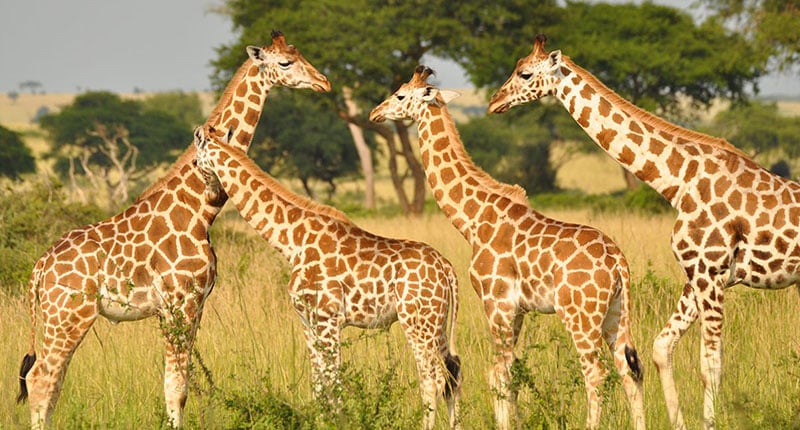
Giraffes are the tallest animals in the world and have fascinated people for centuries. There are nine recognized species of giraffe, each with its unique characteristics and habits. In this article, we will take an in-depth look at the nine species of giraffe, including their habitat, diet, behavior, and conservation status.
The Nine Species of Giraffe
- Northern Giraffe (Giraffa Camelopardalis) The northern giraffe, also known as the Nubian giraffe, is found in countries like Ethiopia, Kenya, and Sudan. They are the tallest of all the giraffe species, with males reaching a height of 18 feet. They have a distinctive coat pattern with large, irregular spots that are separated by white lines.
- Southern Giraffe (Giraffa Giraffa) The southern giraffe is found in southern African countries like South Africa, Namibia , and Botswana. They have a coat pattern that consists of smaller, more defined spots that are closely spaced. They have a darker coloration compared to other giraffe species.
- Reticulated Giraffe (Giraffa Reticulata) The reticulated giraffe is found in northern Kenya, Somalia, and Ethiopia. They have a unique coat pattern that consists of large, rectangular patches that are separated by narrow white lines. Their coat pattern is often compared to a net or web-like structure, hence the name “reticulated.”
- Masai Giraffe (Giraffa Tippelskirchi) The Masai giraffe is found in Kenya and Tanzania, and they are the tallest subspecies of giraffe. They have an irregular coat pattern with large, leaf-shaped spots that are separated by jagged lines.
- Rothschild’s Giraffe (Giraffa Rothschildi) Rothschild’s giraffe is found in Kenya and Uganda, and they have a coat pattern that is similar to the Masai giraffe. However, their spots are more jagged and have a star-like shape. They are also distinguished by their white lower legs.
- West African Giraffe (Giraffa Reticulata) The West African giraffe is found in countries like Niger and Cameroon. They have a coat pattern that is similar to the reticulated giraffe, but their spots are more jagged and irregular.
- Kordofan Giraffe (Giraffa Camelopardalis) The Kordofan giraffe is found in countries like Chad and Cameroon. They have a coat pattern that is similar to the northern giraffe, but their spots are smaller and more irregular.
- Thornicroft’s Giraffe (Giraffa Thornicrofti) Thornicroft’s giraffe is found in Zambia, and they have a distinctive coat pattern with large, rounded spots that are widely spaced.
- Nubian Giraffe (Giraffa Camelopardalis) The Nubian giraffe is found in Ethiopia and South Sudan, and they have a coat pattern that is similar to the northern giraffe. However, their spots are smaller and more irregular.
Habitat and Diet
Each species of giraffe has a specific habitat where they thrive. Giraffes are primarily found in savannas, grasslands, and open woodlands. They are herbivores and have a specialized diet that consists of leaves, flowers, fruits, and bark. Giraffes have a long tongue that they use to pluck leaves from trees, and they have a unique digestive system that allows them to extract nutrients from tough and fibrous plant material.
Behavior
Giraffes are social animals and live in groups called towers or herds. Tower is a more appropriate term for a group of giraffes, as they are known for their height. Males have a more solitary lifestyle and tend to associate with other males only during the mating season. Giraffes are known for their unique behavior of “necking,” which involves two males using their long necks to engage in combat.
Conservation Status
Giraffes face various threats in the wild, including habitat loss, poaching, and civil unrest. The International Union for Conservation of Nature (IUCN) has listed all nine species of giraffe as “vulnerable” or “endangered.” Several conservation efforts are underway to protect giraffes, including habitat restoration, anti-poaching measures, and captive breeding programs.
Conclusion
Giraffes are one of the most iconic animals in the world, and their distinctive features make them stand out from other wildlife. The nine species of giraffe have their unique characteristics, coat patterns, and behaviors, making each one fascinating to study. However, all giraffe species are under threat due to various factors, and it is our responsibility to ensure their survival for generations to come.
FAQs
1. How long is the tongue of a giraffe?
- Giraffes have a tongue that can grow up to 18 inches long.
2. How many subspecies of giraffe are there?
- There are nine recognized subspecies of giraffe.
3. What is the average lifespan of a giraffe?
- Giraffes can live up to 25 years in the wild and up to 28 years in captivity.
4. Do giraffes have any natural predators?
- Giraffes are not preyed upon by many predators due to their size. However, lions and crocodiles are known to prey on giraffes occasionally.
5. How can I help conserve giraffes?
- You can support conservation efforts by donating to organizations that protect giraffes, participating in eco-tourism activities, and spreading awareness about the importance of preserving wildlife habitats.
